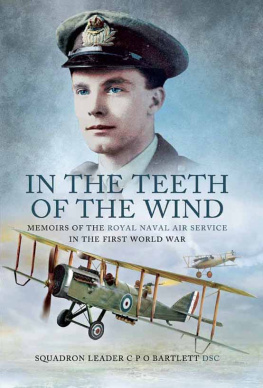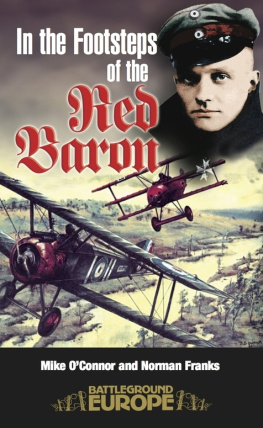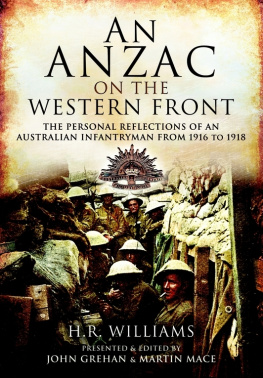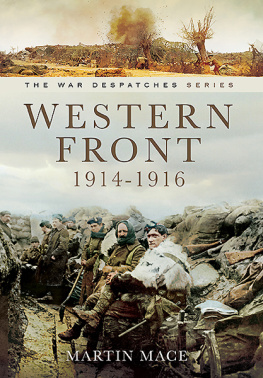IN THE TEETH OF THE WIND
IN THE TEETH OF THE WIND
MEMOIRS OF THE ROYAL NAVAL AIR SERVICE
IN THE FIRST WORLD WAR
C.P.O. Bartlett
Edited by his son,
Nick Bartlett
First published in 1974
by Ian Allan Ltd
Published in 2004
and re-printed in this format in 2013 by
Pen & Sword Military
an imprint of
Pen & Sword Books Ltd
47 Church Street
Barnsley
South Yorkshire
S70 2AS
The right of C.P.O. Bartlett to be identified as author of this work has
been asserted by him in accordance with the Copyright, Designs and
Patents Act 1988.
Copyright C.P.O. Bartlett, 2004, 2013
ISBN:- 978-1-47381-548-3
A CIP catalogue record for this book is available from the British Library.
All rights reserved. No part of this book may be reproduced or transmitted in any
form or by any means, electronic or mechanical including photocopying, recording
or by any information storage and retrieval system, without permission from the
Publisher in writing.
Printed and bound in the UK by CPI Group (UK) Ltd, Croydon, CRO 4YY
Pen & Sword Books Ltd incorporates the Imprints of Pen & Sword Aviation,
Pen & Sword Family History, Pen & Sword Maritime, Pen & Sword Military, Pen
& Sword Discovery, Wharncliffe Local History, Wharncliffe True Crime,
Wharncliffe Transport, Pen & Sword Select, Pen & Sword Military Classics, Leo
Cooper, The Praetorian Press, Remember When, Seaforth Publishing
and Frontline Publishing.
For a complete list of Pen & Sword titles please contact
PEN & SWORD BOOKS LIMITED
47 Church Street, Barnsley, South Yorkshire, S70 2AS, England
E-mail: enquiries@pen-and-sword.co.uk
Website: www.pen-and-sword.co.uk
CONTENTS
Glossary
| AA | Anti-Aircraft |
| AM | Air Mechanic |
| Archie | Nickname for anti-aircraft fire, from contemporary |
| music hall catch-phrase, Archibald, certainly not! |
| Bessoneau(x) | French design of aircraft field hangar, of canvas roof and sides, with bulky wooden internal framework |
| CMB | Central Medical Board (in London) |
| CPO | Chief Petty Officer, Royal Navy |
| DH | DH4 bomber |
| DO | Duty Officer |
| EA | Common abbreviation for enemy aircraft |
| F/Cdr | Flight Commander (RNAS rank) |
| F/Lt | Flight Lieutenant (RNAS rank) |
| F/S/Lt | Flight Sub-Lieutenant (RNAS rank) |
| HE | High Explosive |
| KB | Kite Balloon |
| Lower Deck | Naval Term for non-commissioned ratings |
| Mufti | Civilian clothes |
| PBI | Poor Bloody Infantry |
| Napoo | Useless or non-existent |
| PO | Petty Officer, Royal Navy |
| RFC | Royal Flying Corps |
| RNAS | Royal Naval Air Service |
| RNVR | Royal Naval Volunteer Reserve |
| USAS | United States Air Service |

In July, 1914, when at Churchills instigation the British Admiraltys Air Department was formed into the Royal Naval Air Service, the intention was that its work would be solely to support the Navy. Yet, within weeks of its first squadron arriving in France, RNAS units equipped with armoured cars were skirmishing against the flank of the German army in its advance on Antwerp. Next, at the request of the French, an RNAS seaplane base was established at Dunkirk as a contribution to the defence of the threatened port, and from there a number of spectacular raids were made on Zeppelin sheds as far away as Cologne, Dsseldorf and Cuxhaven notable achievements considering the very primitive aircraft and navigational aids available in 1914.
As the protagonists gradually settled down to trench warfare it became obvious that a huge traffic of men and war material across the Channel would need to be sustained and given the strongest possible protection, the task being given to Vice Admiral Sir Reginald Bacons forces, known as the Dover Patrol. One of its components were the several RNAS squadrons based on aerodromes around Dunkirk.
By the historic resistance of remnants of the small Belgian Army and the opening of the dykes, the German advance on Dunkirk, threatening Calais and Boulogne too, was held near Dixmude, 15 miles to the east. By the end of the year the persistence of British and Belgian troops, fighting in the appalling flooded trenches along the valley of the Yser, had secured an anchorage for the left flank of the 180-mile Allied front which held firm for the rest of the war. The ports of Ostende, Bruges and Zeebrugge, being in German hands, however, posed a constant threat to the supply lines of the British Army, a fact not lost on the enemy who set about building up Bruges to the level of an Imperial Dockyard to harbour 30 destroyers and 35 submarines, and enormous resources were given to building heavy submarine shelters with supporting aerodromes.
The British answer to these threats took several forms, one of which was a force of 15-inch gun monitors, which, working with the spotting planes of the Dunkirk squadrons, bombarded the lock gates of the three harbours, without, however, bottling up the German flotillas. At the same time the operations of my fathers squadron, No.5 Naval, were directed to bombing the ports, first by night, and later with the more powerful DH4 day bomber.
In July, 1917, Sir Douglas Haig asked for the help of the Dunkirk naval squadrons to support the offensive he was planning, which had the objective of capturing Bruges and the German submarine bases in Flanders, as well as turning the enemy flank. This major strategic plan called for a break-out from the Ypres Salient which would thrust behind the German right. The battles which followed were known as the Third Battle of Ypres and eventually bogged down in the mud of Passchendaele. 5 Naval Squadrons part in this battle was to bomb railway centres and airfields in order to draw enemy air strength away from the battle zone. These operations were interrupted when the Germans began the long-range bombing of London by Gotha night bombers, the first use of strategic bombing of population centres. There were immediate demands for elaborate home air defences to be created, and for attacks on the Gothas bases near Ghent, my fathers squadron being given the task.
The collapse of Russia in October, 1917, releasing large numbers of divisions from the Eastern Front, suggested that the enemy would mount a major effort in the Spring, to crush the Allies before the Americans arrived in strength. The point of attack was not known but the enemys aerodromes were bombed regularly to hinder his reconnaissance work, 5 Naval moving south for this purpose, to the area of the old Somme battlefield. In a sense this was fortunate, enabling the squadron to play an important part in the desperate crisis of the March, 1918, Ludendorff Offensive, when it found itself at the point where a gap opened up between the collapsing British Fifth Army and the French, a crisis in which the Allies very nearly lost the war.
In the course of these operations my father flew on 101 bombing raids, all in the space of eighteen months at this time of the war a pilots life was reckoned in weeks. Tribute is also owed to the gunlayers. On their skill in lining up over the target and, perhaps at the same time repulsing attacking fighters, depended success or failure, and should the pilot be severely wounded, their lot would not be enviable. For both, flying in open cockpits at 16,000 feet or so without either heat or oxygen, there was an inevitable toll, yet, as this record shows, there was the pure joy of flying, the exuberance of a young man let loose in the air.
Next page












